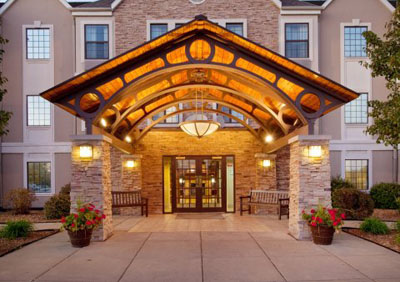A public hearing will be held at Tuesday evening’s City Council meeting on a proposed amendment to the downtown Hospitality Improvement Zone Business District Development Plan (or HIZ BDD Plan, for short). The amendment consists of these two changes:
- Adding Staybridge SuitesIn order to add property to the HIZ BDD Plan, the added property has to qualify as “blighted.” According to state ordinance a “blighted area” is an area
which, by reason of the predominance of defective, non?existent, or inadequate street layout, unsanitary or unsafe conditions, deterioration of site improvements
the definition of timesheet>, improper subdivision or obsolete platting, or the existence of conditions which endanger life or property by fire or other causes, or any combination of those factors, retards the provision of housing accommodations or constitutes an economic or social liability, an economic underutilization of the area, or a menace to the public health, safety, morals, or welfare. [65 ILCS 5/11-74.3-5]
According to the council communication [note: large PDF file], Staybridge Suites qualifies “due to the deterioration of site improvements which constitutes an economic underutilization of the area.”Staybridge Suites was built in 1999 for around $7.5 million. In twelve years, we’re supposed to believe that it’s now “blighted” due to “the deterioration of site improvements”? Well, maybe, if it was built by the same contractor that built Riverfront Village. Still, if this is “blighted,” then every building in the City of Peoria is blighted:

Looks like a real dump, doesn’t it? It’s worth noting that the council communication does not provide any documentation to substantiate this supposed “deterioration” and “economic underutilization.” It simply makes the claim without any evidence to back it up.
- Doubling estimated business district project costsThis is perhaps the most curious part of the amendment. The amendment increases the total estimated business district project costs from $6 million to $12 million. They’ve also lengthened the list of things on which they can spend that money. Here’s a comparison between the original plan and the proposed amendment:
Original BDD Plan Amended BDD Plan (Proposed) The Business District costs are estimated at $6,000,000 and may include: - Buying and selling of land.
- Infrastructure improvements.
- Rehabilitation of existing property.
- Development costs associated with new taxable private development.
- Façade and streetscape improvements.
Business District project costs are estimated at $12,000,000 and may include the following, in accordance with the provisions of the Act: - Cost of studies, surveys, development of plans and specifications, implementation and administration of a business district plan, and personnel and professional service costs.
- Property assembly costs.
- Site preparation costs.
- Costs of installation, repair, construction, reconstruction, extension or relocation of public streets, public utilities and other public site improvements within or without the business district which are essential to the preparation of the business district for use in accordance with the business district plan.
- Costs of renovation, rehabilitation, reconstruction, relocation, repair, or remodeling of any existing buildings, improvements, and fixtures within the business district.
- Costs of installation or construction within the business district of buildings, structures, works, streets, improvements, equipment, utilities, or fixtures.
- Financing costs.
- Relocation costs
What is the meaning of all these additions? You know there’s a reason these changes are being made. If the original plan were sufficient, there would be no need for this amendment. Look closely at some of these changes.
Note in particular number 4 in the amended list: HIZ BDD funds can be used for improvements “within or without [emphasis added] the business district which are essential to the preparation of the business district….” If I’m reading this correctly, it would appear that funds from the HIZ BDD could be used to prepare the new Big Al’s site, for instance, even though that site is not in the HIZ BDD, because moving Big Al’s is “essential” to a project in the business district. And check out number 8: “relocation costs.” Who do we know in the HIZ BDD that would be relocating? Number 7 should give us all pause: “financing costs.” I shudder to think what could be included under that item.
Bottom line, raising the total estimated project costs figure means that the City can borrow (i.e., issue bonds) up to that amount and use HIZ BDD tax revenues for repayment. But HIZ BDD revenue has already been promised toward the repayment of the proposed Wonderful Development $37 million bond issue (if/when that ever comes to fruition). Nowhere does the City show that it could afford this increase in project costs, given our outstanding commitments for that same pot of money.
Remember, if there isn’t enough revenue from the HIZ BDD tax and HIZ TIF revenues to make the payments on the Wonderful Development bonds, guess where they will get the money to repay those bonds? That’s right: the general fund. If you’ll recall, the City is planning to issue general obligation bonds for the Wonderful Development, which will be backed by the full faith and credit of the City of Peoria.
There is more to the expansion of the Hospitality Improvement Zone than meets the eye. The City Council and staff should disclose to the public why they want these changes and what they will mean to our financial situation so that the public hearing process can be as productive as possible.
